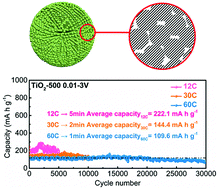Constructing porous TiO2 crystals by an etching process for long-life lithium ion batteries†
Abstract
“Zero strain” materials, which have no volume change when charging and discharging, show ultra-long cycling stabilities when used as lithium-ion battery anodes, making them an area of extreme interest in this decade. For a typical anatase TiO2 crystal, the volume change is 3–4% during Li insertion/extraction, which is not “zero strain”. As the Ti/O packing in the TiO2 lattice is too tight, there is insufficient void space for Li insertion, leading to volume expansion and structural collapse. Herein, pseudo-“zero-strain” TiO2 is achieved via designing TiO2 crystals with abundant inner mesopores, making Ti/O loose-packed via the acid-etching of K2Ti8O17, providing sufficient space for Li intercalation. Instead of the traditional cut-off potential of 1 V used for Ti-/Nb-based anodes, we choose 0.01 V as the cut-off to make the best of the extra capacity contributed by the mesopores. As expected, plenty of mesopores could serve as “Li+-reservoirs” for fast lithium storage, demonstrating exceptional high-rate performance with an average capacity of 109.6 mA h g−1 after 30 000 cycles at 60 C and 100 mA h g−1 at 120 C. Such a strategy of combining a mesoporous structure and cut-off potential regulation may pave a solid pathway for constructing novel high-power anodes.



 Please wait while we load your content...
Please wait while we load your content...